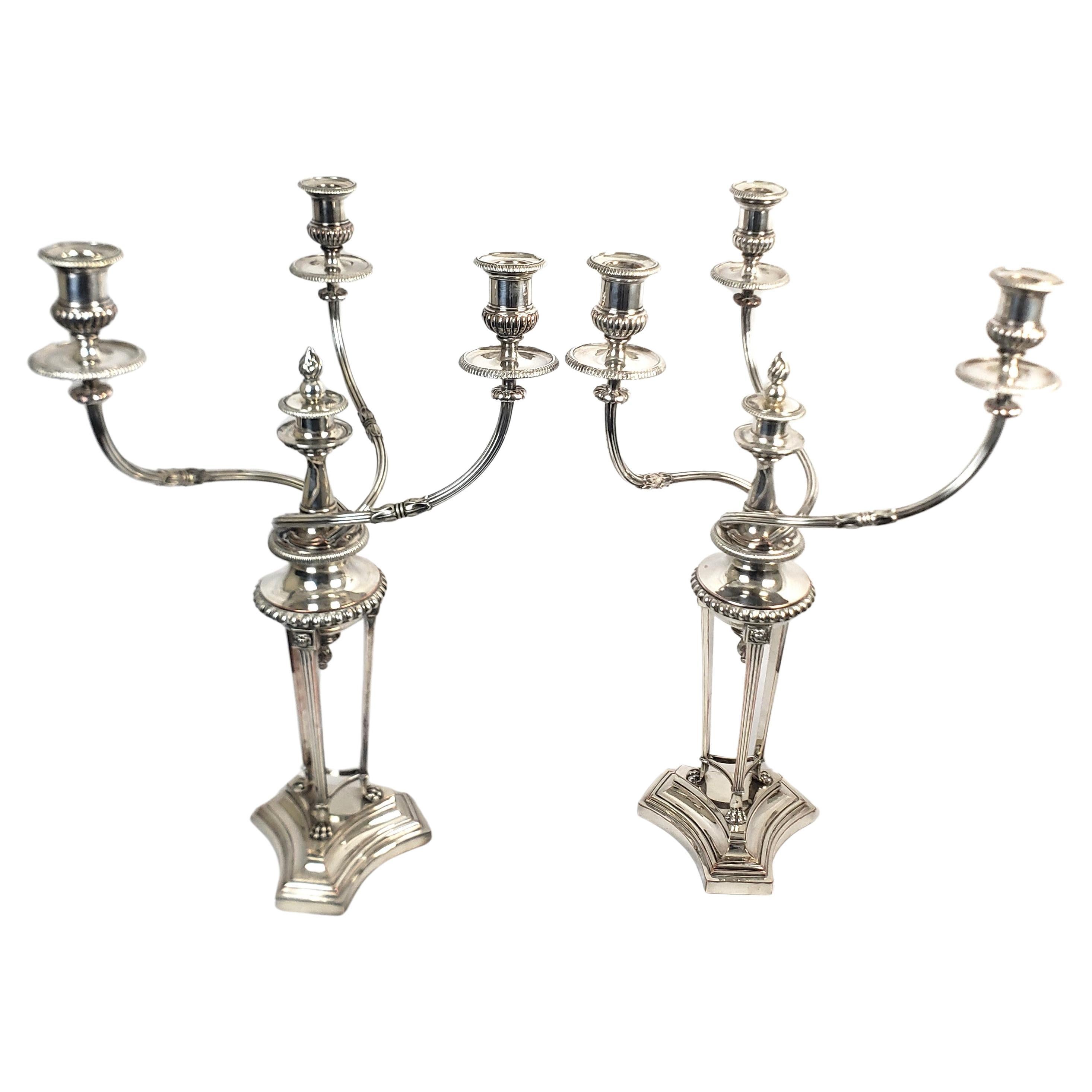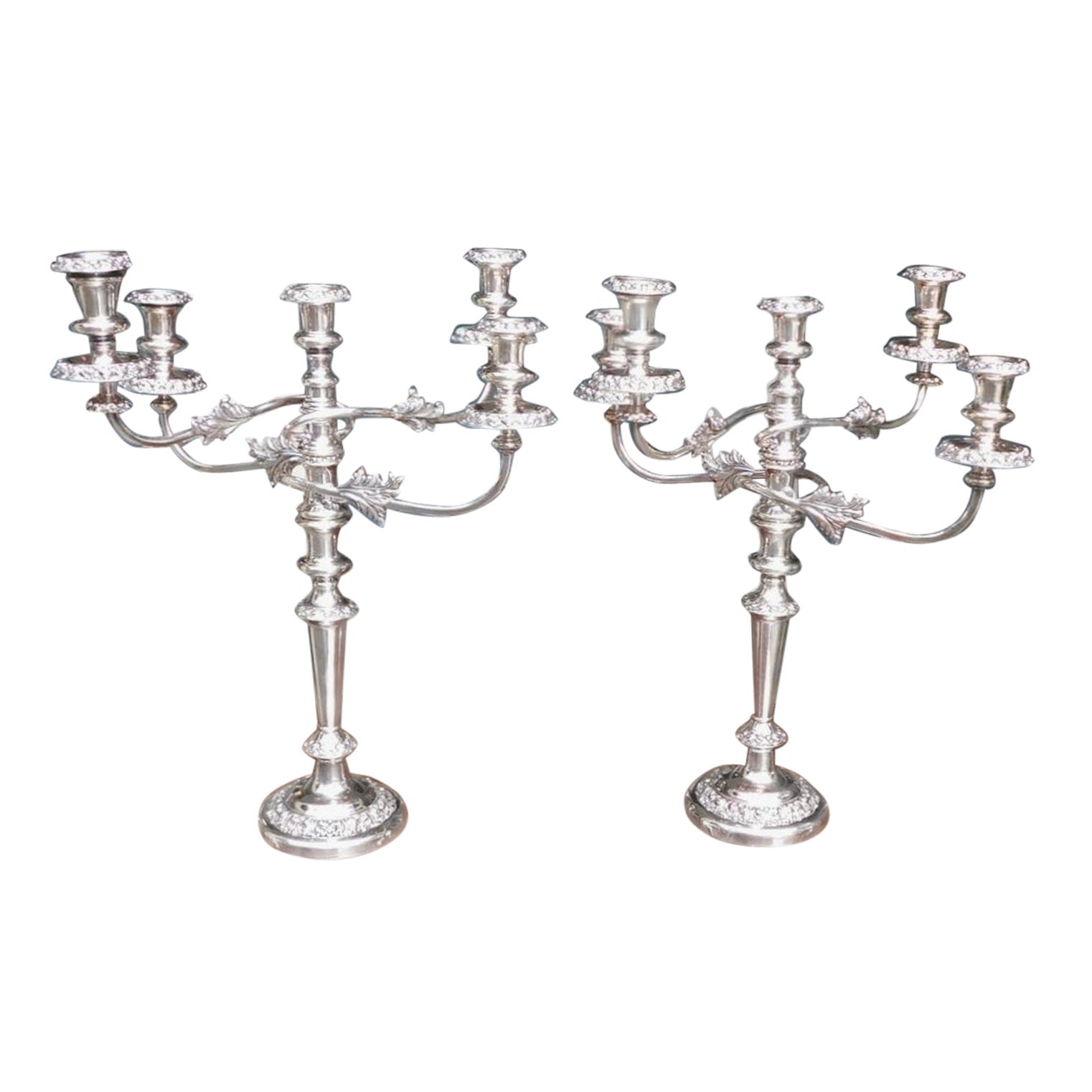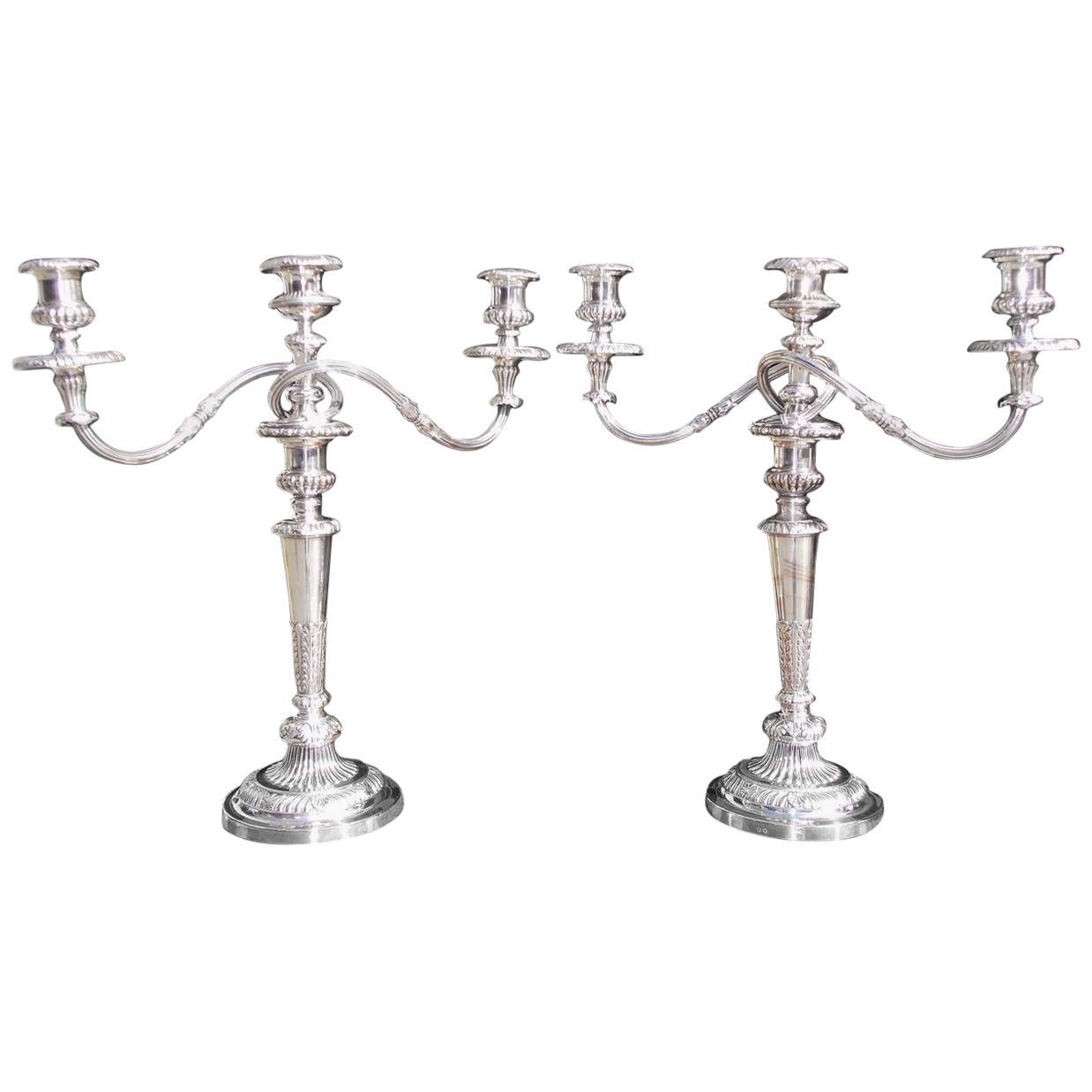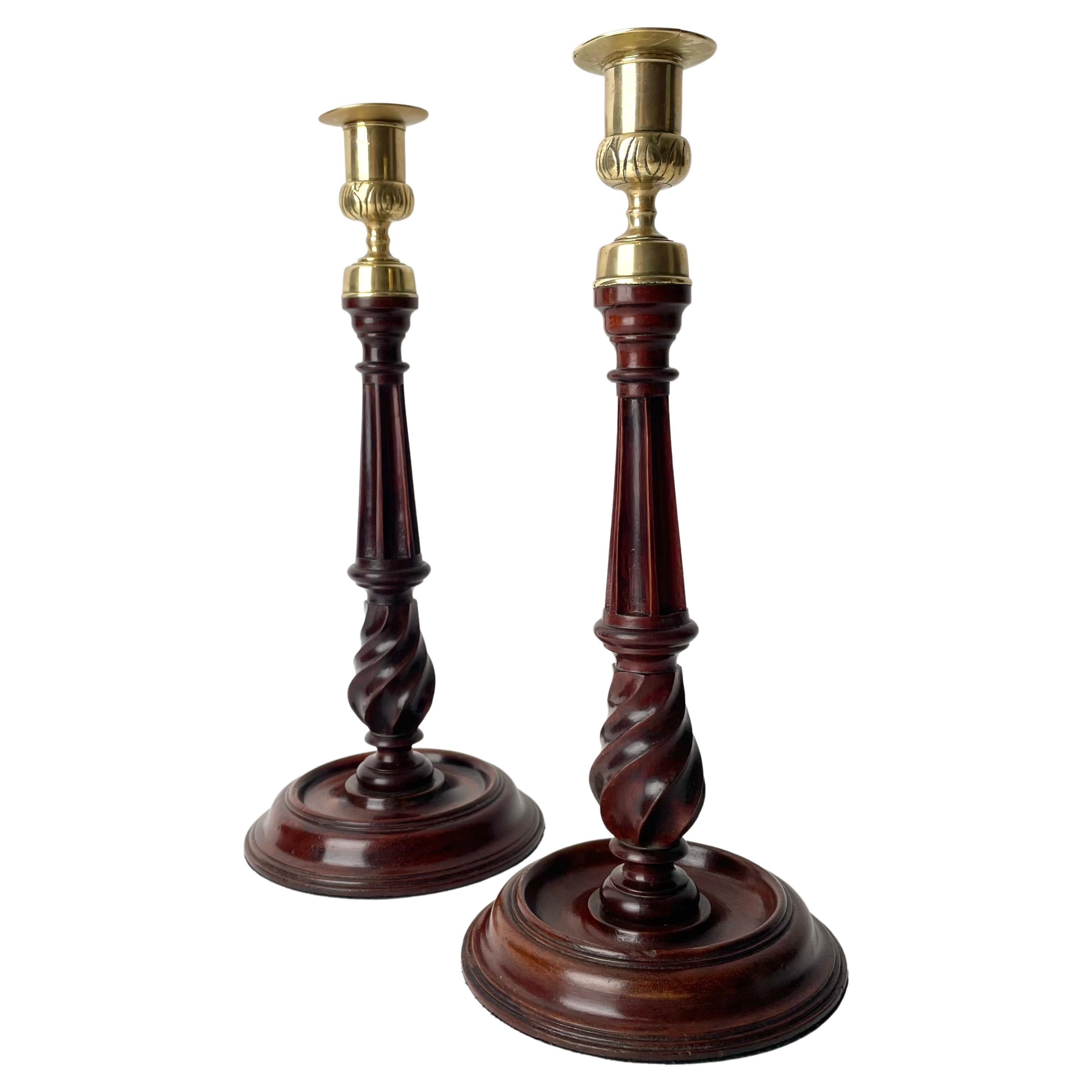Items Similar to Antique Pair 21inch George III Three Light Candelabra by Matthew Boulton 18th C
Want more images or videos?
Request additional images or videos from the seller
1 of 14
Antique Pair 21inch George III Three Light Candelabra by Matthew Boulton 18th C
About the Item
This is a stunning monumental pair of antique English Old Sheffield silver on copper, three light, two-branch table candelabra, circa 1790 in date, and bearing the sunburst makers marks of the world renowned silversmith Matthew Boulton.
The candelabra feature detachable sconces, have beautiful reeded decoration to the twisted reeded branches, columns with urn sconces above drip trays and are raised on decorative circular bases.
The attention to detail is absolutely fantastic and they are certain to attract attention wherever they are placed.
Condition:
In excellent condition with clear makers marks and no dings, dents or signs of repair. Please see photos for confirmation.
Dimensions in cm:
Height 53 cm x Width 43 cm x Depth 15 cm
Dimensions in inches:
Height 1 foot, 9 inches x Width 1 foot, 5 inches x Depth 6 inches
Matthew Boulton
Boulton was not a "goldsmith" or a "silversmith" in the accepted sense, yet for his achievements and services to the craft of goldsmithing he is fully worthy of inclusion in the list of great English goldsmiths.
Matthew Boulton was born in Birmingham on 3 September 1728. His father Matthew Boulton (senior) was a "toy maker" and silver stamper specialized in the production of shoe-buckles.
Boulton junior was taken into partnership in 1749 and was left in sole charge of the business after the death of his father in 1759.
Boulton had the ambition to establish a manufacturing complex where craftsmen in the various branches of the "toy" trade would work together under one roof, enabling him to reap both wholesale and retail profits. In 1761 he realized his project purchasing a one-hundred- year-lease of the "Soho" estate at Handswoth Heath (two miles from Snow Hilton the Wolverhampton Road).
In 1762 Boulton took into unofficial partnership John Fothergill who would act as a travelling salesman to advertise his wares and the factory moved to Soho in the same year.
The partnership concentrated in the production of steel "toys" a little later on buttons and buckles made in a variety of substances, including , of course, silver. In 1762 Soho factory began to produce articles in "Sheffield" plate and one of the first to adopt "Sterling silver thread" edging which prevent to reveal the underlying copper.
Boulton soon became the largest manufacturer of "Sheffield plate" of the country expanding the business of Soho manufactory in the production of bijouterie, objects d'art and de virtue, in ormolu, pinchbeck and in clocks.
In 1765 Boulton began the manufacture of pieces in solid silver, being obliged to send every piece of plate to Chester to be marked (Chester was the nearest assay office, 72 miles away from Birmingham). Boulton was the promoter a petition obtaining in 1773 the Royal Assent to assay silver in Birmingham (the same was for Sheffield).
Boulton & Fothergill entered their joint mark consisting of their initials, MB before IF. After the death of Fothergill (1782) Boulton punched his plate with his initials alone.
When manufacturers of plated ware were permitted to register their marks at the Assay Office in Sheffield (1784), Boulton registered his mark of "twin suns" under the name Boulton M. & Co.
The most important designers for Boulton plate in the neo-classic taste were Robert Adams and James Wyatt.
Matthew Boulton died on 17 August 1809.
The mark MB continued to be used by Matthew Boulton Plate Co until 1832.
Old Sheffield Plate - or ‘fused plate’ as it is sometimes known, was the first commercially viable method of plating metal.
The material was accidentally invented by Thomas Boulsover, of Sheffield's Cutlers Company, in 1743. While trying to repair the handle of a customer's decorative knife, he heated it too much and the silver started to melt. When he examined the damaged handle, he noticed that the silver and copper had fused together very strongly. Experiments showed that the two metals behaved as one when he tried to reshape them, even though he could clearly see two different layers.
Boulsover set up in business, funded by Strelley Pegge of Beauchief, and carried out further experiments in which he put a thin sheet of silver on a thick ingot of copper and heated the two together to fuse them. When the composite block was hammered or rolled to make it thinner, the two metals were reduced in thickness at similar rates. Using this method, Boulsover was able to make sheets of metal which had a thin layer of silver on the top surface and a thick layer of copper underneath. When this new material was used to make buttons, they looked and behaved like silver buttons but were a fraction of the cost.
The technique Boulsover developed was to sandwich an ingot of copper between two plates of silver, tightly bind it with wire, heat it in a furnace and then mill it out in to sheet, from which objects could be made.
Our reference: A3808a
- Dimensions:Height: 20.87 in (53 cm)Width: 16.93 in (43 cm)Depth: 5.91 in (15 cm)
- Sold As:Set of 2
- Style:George III (In the Style Of)
- Materials and Techniques:
- Period:1790-1799
- Date of Manufacture:circa 1790
- Condition:
- Seller Location:London, GB
- Reference Number:
About the Seller
5.0
Platinum Seller
These expertly vetted sellers are 1stDibs' most experienced sellers and are rated highest by our customers.
Established in 1983
1stDibs seller since 2012
1,199 sales on 1stDibs
Typical response time: <1 hour
Associations
LAPADA - The Association of Arts & Antiques Dealers
- ShippingRetrieving quote...Ships From: London, United Kingdom
- Return PolicyA return for this item may be initiated within 14 days of delivery.
More From This SellerView All
- Antique George III Wine Cooler by Matthew Boulton with Hamilton Crest 18th CLocated in London, GBThis is an elegant antique English Old Sheffield plate silver on copper ice bucket or wine cooler, circa 1790 in date, and bearing the sunburst makers marks of the world renowned sil...Category
Antique 1790s Wine Coolers
MaterialsSilver Plate
- Antique Pair Victorian 5 Light Candelabra James Dixon 19th CLocated in London, GBThis is a stunning pair of English antique Neo Classical design Victorian silver plated, five light, four-branch table candelabra, circa 1880 in date, and each bearing the makers mar...Category
Antique 1880s Candelabras
MaterialsSilver Plate
- Antique Pair George III Demi Lune Console Tables 18th CenturyLocated in London, GBThis is a superb pair of antique George III solid fruitwood demi-lune console tables, possibly Anglo Chinese, circa 1780 in date. Each console has a beautiful half moon shaped top...Category
Antique 1780s English George III Console Tables
MaterialsFruitwood
- Antique George III Scottish Mahogany Bowfront Sideboard 18th CenturyLocated in London, GBThis is a fine antique Scottish flame mahogany and line inlaid bowfront sideboard made in the reign of George III, circa 1790 in date. The splendid piece features a central frieze ...Category
Antique 1790s Scottish George III Sideboards
MaterialsMahogany
- Antique George III Inlaid Flame Mahogany Sideboard, 18th CenturyLocated in London, GBThis is a superb antique George III inlaid flame mahogany bowfront sideboard, circa 1780 in date. The top is banded in satinwood and...Category
Antique 1780s English George III Sideboards
MaterialsMahogany
- Antique George III Old Sheffield Silver Plated 18th CenturyLocated in London, GBThis is an exquisite English antique old Sheffield plate salver, circa 1780 in date. The elegant raised pie crust border shaped salver featu...Category
Antique 1780s English George III Sheffield and Silverplate
MaterialsSheffield Plate
You May Also Like
- Pair of Huge Antique Matthew Boulton Regency Three Arm Silver Plated CandelabrasBy Matthew BoultonLocated in Hamilton, OntarioThis pair of large and substantial silver plated candelabras were made by the renowned Matthew Boulton on England in apprximately 1810 and done in a period Regency style. The pair ar...Category
Antique Early 19th Century English Regency Candelabras
MaterialsSilver Plate
- Pair of Regency Gilt Bronze Figural Candelabra by Matthew BoultonBy Matthew BoultonLocated in Essex, MADepicting a boy holding candelabra arms on a stepped circular base with guilloche decoration.Category
Antique Early 19th Century English Regency Candelabras
- Pair of English Regency Sheffield Candelabras, Matthew Boulton, Circa 1800By Mathew BoltonLocated in Hollywood, SCA complete pair of English Regency Sheffield five-light candelabras with removable intertwined scrolled arms, original hand chased removable foliage motif bobeches, bulbous floral tapered columns, and resting on foliage motif circular bases. Candelabra bobeches...Category
Antique Early 1800s English Regency Candelabras
MaterialsSheffield Plate, Copper
- Pair of English Regency Sheffield Candelabras, Matthew Boulton, Circa 1800By Mathew BoltonLocated in Hollywood, SCA complete pair of English Regency Sheffield three-light candelabras with removable intertwined scrolled arms, original hand chased removable shell motif bobeches, beaded floral tape...Category
Antique Early 1800s English Regency Candelabras
MaterialsSheffield Plate, Copper
- A Pair Of George Iii Cut Glass Candelabra By William ParkerBy William ParkerLocated in Steyning, West sussexThe square concave bases of urn form, mounted with diamond cut containers issuing four notch cut arms, two of scroll form supporting drip pans and candle save all's, a further two mo...Category
Antique 18th Century English George III Candelabras
MaterialsCut Glass
- Pair of Candlesticks, Mahogany and Brass, George III England Late 18th C.Located in Knivsta, SEA Pair of Candlesticks in Mahogany (Swietenia mahagoni) and Brass. George III. Made in England during the late 18th century. Richly decorated and filled with rare and intricate det...Category
Antique Late 18th Century English George III Candlesticks
MaterialsBrass





